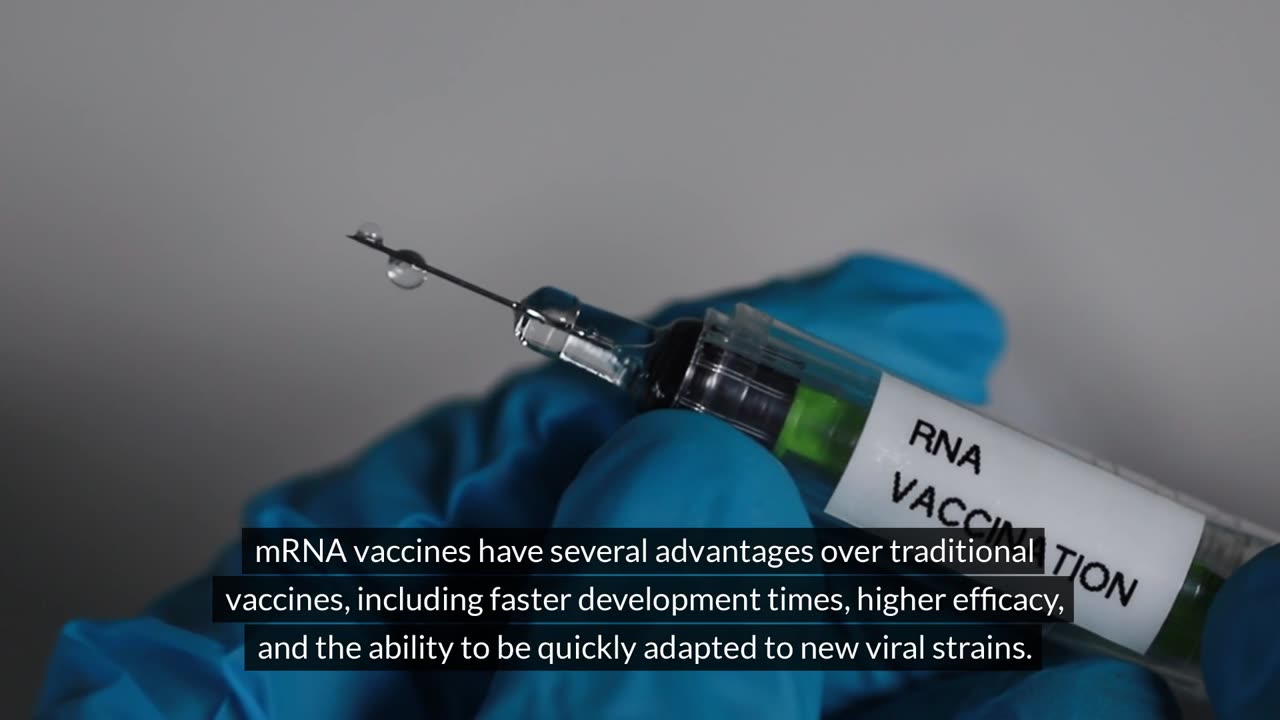Premium Only Content

The Race Against Bird Flu: Moderna’s $176 Million Quest for a Pre-Pandemic Vaccine
A New Frontier in Vaccine Development
As the world continues to grapple with the aftershocks of the COVID-19 pandemic, another potential threat is looming on the horizon: bird flu. The H5N1 avian influenza virus has sparked concerns with recent outbreaks in dairy cattle and human infections among farm workers. In response, the U.S. government has awarded Moderna $176 million to expedite the development of an mRNA-based bird flu vaccine. With the specter of another pandemic on the horizon, the race to develop an effective vaccine is more critical than ever.
## Chapter 1: Understanding H5N1 – The Threat We Face
### What is H5N1?
H5N1, also known as bird flu, is a highly pathogenic avian influenza virus that primarily affects birds but can also infect humans. The virus was first identified in 1997 in Hong Kong and has since caused numerous outbreaks in poultry and wild birds worldwide. While human infections are rare, they are often severe and have a high mortality rate.
### Recent Outbreaks and Human Infections
In March, the U.S. reported its first outbreak of H5N1 in dairy cattle, marking a troubling expansion of the virus's reach. Since then, over 130 herds in 12 states have been affected, and three dairy workers have contracted the virus. These developments have heightened concerns among scientists about the potential for the virus to mutate and gain the ability to spread easily among humans.
### The Risk of Mutation
One of the greatest fears surrounding H5N1 is its potential to mutate into a form that can be easily transmitted between humans. Such a mutation could lead to a global pandemic, similar to the one caused by the novel coronavirus. Scientists warn that the dense environments of poultry and dairy operations could facilitate this mutation, making it imperative to monitor and contain outbreaks swiftly.
## Chapter 2: The Role of mRNA Technology – A Game Changer
### How mRNA Vaccines Work
Messenger RNA (mRNA) vaccines work by instructing cells in the body to produce a protein that triggers an immune response. Unlike traditional vaccines, which use weakened or inactivated forms of a virus, mRNA vaccines use a small piece of the virus's genetic code. This approach not only produces a robust immune response but also allows for rapid development and scalability.
### Success During the COVID-19 Pandemic
The success of mRNA vaccines during the COVID-19 pandemic demonstrated their potential to revolutionize vaccine development. Both Moderna and Pfizer's mRNA vaccines were developed, tested, and distributed in record time, saving countless lives and proving the efficacy of this new technology.
### Advantages of mRNA for Bird Flu
Moderna CEO Stephane Bancel highlights several advantages of mRNA technology in addressing infectious disease outbreaks. These include faster development and production times, higher efficacy, and greater scalability compared to conventional flu vaccines. As the threat of H5N1 looms, these benefits could be crucial in preventing a new pandemic.
## Chapter 3: Government Support and Strategic Planning
### The $176 Million Investment
The U.S. Biomedical Advanced Research and Development Authority (BARDA) has awarded Moderna $176 million to advance the development of its bird flu vaccine. This funding will support late-stage development and testing, with a focus on ensuring safety and efficacy. The government is prepared to accelerate the development timeline if necessary, based on the severity and spread of the virus.
### Potential for Rapid Deployment
Moderna's contract includes provisions to speed up the development process in response to an increase in human cases or the emergence of human-to-human transmission. Late-stage testing is slated to begin in 2025, pending the results of current phase 1 trials. The goal is to have a ready-to-deploy vaccine if the situation escalates.
### Collaboration with Other Companies
In addition to Moderna, the U.S. government is negotiating with Pfizer to develop another mRNA-based H5N1 vaccine. By leveraging the strengths of multiple companies, officials aim to ensure a robust and diversified response to the threat of bird flu.
## Chapter 4: Addressing Public Health Concerns
### Vaccination Strategies
Currently, vaccination for bird flu is not recommended for the general public, as the risk remains low. However, discussions are ongoing about the potential benefits of vaccinating farm workers and others at high risk of exposure. Protecting these individuals could help prevent the virus from spreading to the wider population.
### Ensuring Food Safety
Concerns about the safety of dairy products have also arisen in light of the H5N1 outbreaks in dairy cattle. The U.S. Food and Drug Administration (FDA) has conducted lab experiments confirming that pasteurization inactivates the bird flu virus. Ongoing tests of retail dairy products aim to ensure that consumers are not at risk.
### Combating Misinformation
Public health officials emphasize the importance of combating misinformation about H5N1 and the vaccines. Accurate and timely information is crucial to ensuring public trust and compliance with health measures. Efforts to educate the public about the benefits and safety of mRNA vaccines are essential in preventing panic and ensuring a coordinated response.
## Chapter 5: Preparing for the Future
### The Need for Vigilance
The resurgence of H5N1 serves as a stark reminder of the need for vigilance in public health. While the immediate risk to the general public is low, the potential for the virus to mutate and cause a pandemic cannot be ignored. Continuous monitoring and preparedness are crucial to preventing a future crisis.
### Strengthening Public Health Infrastructure
Investing in public health infrastructure is essential to ensure a swift and effective response to emerging threats. This includes maintaining robust surveillance systems, ensuring adequate vaccine supplies, and having well-trained personnel ready to act. The lessons learned from the COVID-19 pandemic can guide efforts to strengthen our defenses against future outbreaks.
### Global Cooperation
Bird flu is a global issue that requires international cooperation. Sharing data, resources, and best practices can help countries effectively manage and contain outbreaks. Organizations like the World Health Organization (WHO) play a pivotal role in coordinating these efforts and ensuring a unified response.
Taking Action to Prevent a Pandemic
The threat of H5N1 bird flu is real, but with proactive measures, we can prevent it from becoming a global crisis. The U.S. government’s investment in Moderna’s mRNA vaccine development is a crucial step in this direction. By staying vigilant, investing in public health, and fostering global cooperation, we can protect ourselves and future generations from the devastating impact of a pandemic.
Thank you for reading! If you found this article informative, please share it with your friends and family. Don’t forget to subscribe to our channel for more updates, like this post, and leave your thoughts in the comments below. Together, we can stay informed and prepared.
-
 1:30:55
1:30:55
Flyover Conservatives
23 hours agoDrones, Darkness, and Divine Intervention: Unpacking Prophecy and Reality - Dr. Troy Spurrill | FOC Show
28.6K1 -
 59:32
59:32
The StoneZONE with Roger Stone
4 hours agoHonoring Great American Patriots for Helping to Save our Country | The StoneZONE w/ Roger Stone
58.1K5 -
 1:09:50
1:09:50
Donald Trump Jr.
9 hours agoHow Sean Parnell Helped Deliver PA, Plus Why Pete Hegseth Must Be Confirmed | TRIGGERED Ep.199
187K85 -
 1:58:03
1:58:03
Tucker Carlson
6 hours agoJeffrey Sachs: The Inevitable War With Iran, and Biden’s Attempts to Sabotage Trump
184K297 -
 1:31:00
1:31:00
Redacted News
9 hours agoBREAKING! Trump demands answers on UFOs over America as Pentagon hides the truth | Redacted News
192K332 -
 1:07:45
1:07:45
BIG NEM
7 hours agoSpiritual STDs, Nikola Tesla & Harnessing Creative Energy! ⚡💡
30.2K2 -
 38:09
38:09
Patriots With Grit
6 hours agoWe Must Finish This Fight | Glenn Baker
23.6K -
 54:52
54:52
LFA TV
1 day agoWhy Did God Bring Donald Trump Back to the White House? | Trumpet Daily 12.16.24 7PM EST
40.3K9 -
 1:33:00
1:33:00
2 MIKES LIVE
13 hours ago2 MIKES LIVE #156 Author Frank Lasee will Deep Dive into CLIMATE CHANGE!
26.2K1 -
 15:36
15:36
DeVory Darkins
1 day ago $32.10 earnedGLOVES OFF: Scott Jennings hits CNN Panel with knockout blow
94.1K95